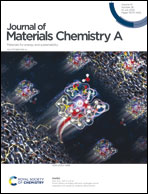Protic ethers as highly efficient hydrogen-bond regulators for aqueous eutectic electrolytes†
Abstract
Aqueous eutectic electrolytes are emerging as the cost-effective and environmentally benign alternatives governing the next-generation electrochemical energy storage (EES) devices. For example, Li-based eutectic (ALE) electrolyte benefits from the strong hydrogen bond (H-bond) interaction with dimethyl sulfoxide (DMSO)–H2O eutectic mixtures, exhibiting non-flammability and high electrochemical stability compared to conventional aqueous electrolytes. However, the highly concentrated feature raises obstacles to sluggish ions transfer and low-temperature performance, limiting the practical application of ALE electrolytes. Herein, a novel approach regarding organic solvent regulation has been proposed to deal with concentration-related electrochemical-stability issues. For instance, the protic ether of 1,2-dimethoxyethane (DME) in the ALE electrolyte (ALE–DME6.6) can efficiently occupy the primary solvating shell of Li+ and increase H-bond intensity between DME–H2O and DMSO–H2O, which ultimately delivers high capacitance of 66.2 F g−1 at 0.5 A g−1 and ∼80% capacitance retention after 20 000 cycles at room temperature. In addition, enhanced low-temperature operation in supercapacitors (SCs) displays high ionic conductivity of 0.62 mS cm−1 and high capacitance retention of 80% (8000 cycles) at −20 °C. The DME regulator in eutectic electrolytes offers appealing prospects and guidance for the advanced design of eutectic electrolytes for diverse EES applications.



 Please wait while we load your content...
Please wait while we load your content...